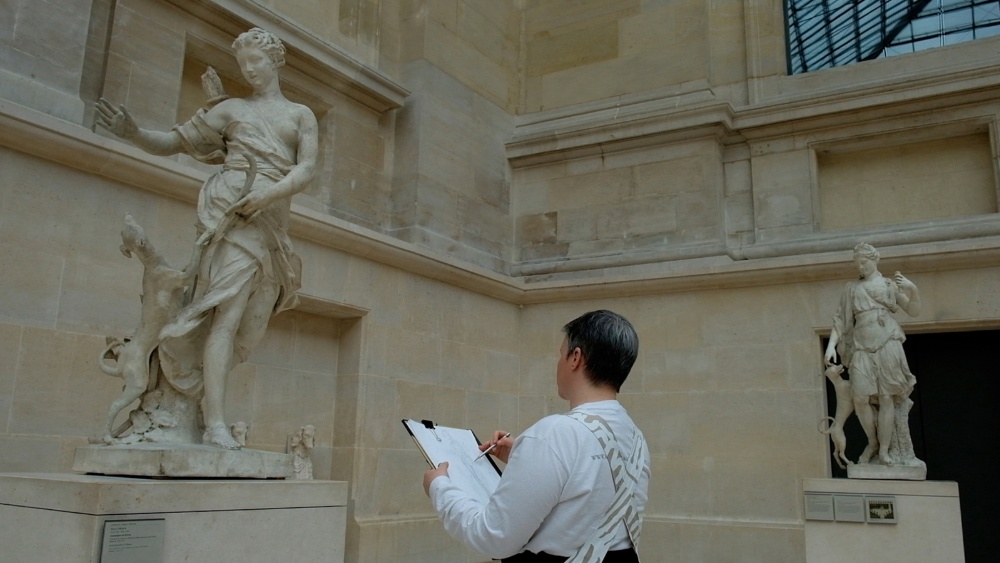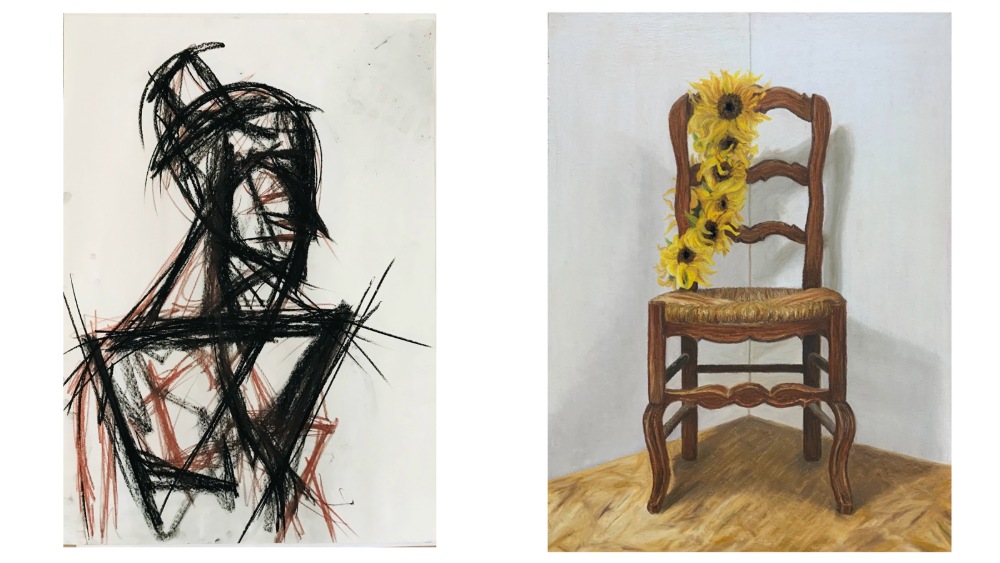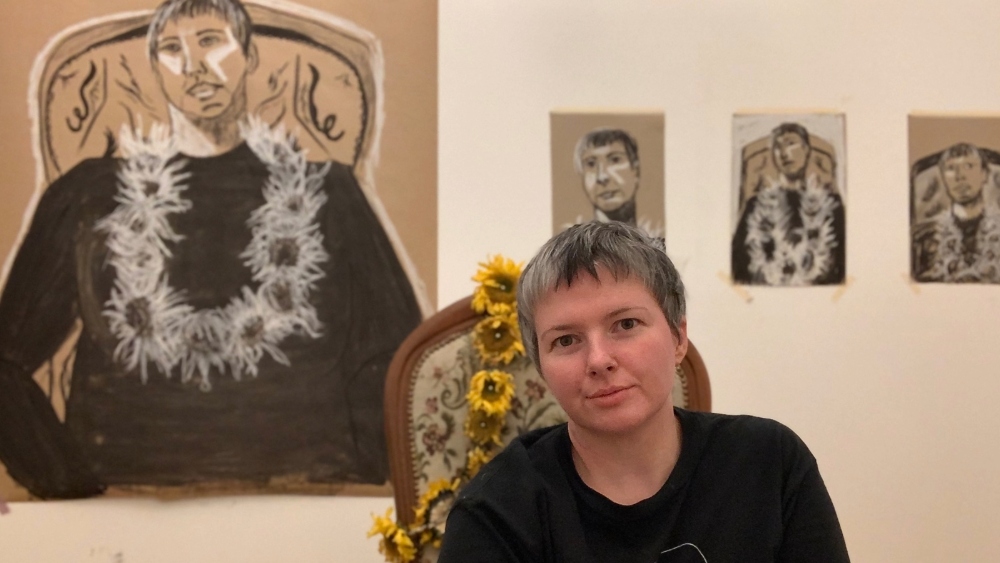Advocacy through imagery with UOW graduate Melissa Hammond
Channelling the pain and grief of a life-changing accident into art success on the world stage
August 8, 2025
For award-winning multidisciplinary artist Melissa Hammond, her recent artistic achievements are a way to reach more people and create positive change for people with invisible disabilities.
While she’s no stranger to big life moments, has had a rollercoaster 12 months.
“Things are moving so fast that I haven’t been able to actually feel all the different wins and the losses,” she says. “When I stop and reflect, a lot has happened!”
In 2024, Melissa was awarded a month-long art residency at the internationally renowned in France. She followed this experience with one of only eight spots in Paris’s prestigious ’s intensive winter program at the Louvre.
“These opportunities gave me the freedom and space to explore my artistic voice, complemented by formal classical training. It was very surreal,” Melissa says. “I came back with certainty of what I needed to do next. I started applying advocacy through my artwork more strategically and with a renewed motivation behind it.”
She soon found herself selected for the biggest annual art event in UK, the in London. Held annually since 1769, the Summer Exhibition is the largest open submission exhibition in the world and the longest continuously staged exhibition of contemporary art. Melissa sees this as an opportunity for thousands of people to be introduced to her art and her message.
When asked about her advocacy, Melissa explains that it makes more sense if you know how she came to art.

Melissa Hammond during her Studio Escalier Art School program at the Louvre. Photo credit: Sunny Rae Keller.
A visual expression of emotion, grief and pain
Melissa has always been a creative person and a passionate advocate, particularly around environmental issues. After earning a Bachelor of Mathematics and Economics (Honours) from the ÁñÁ«ÊÓƵapp of ÁñÁ«ÊÓƵapp (UOW), she moved to Canberra and began working for the government, eager to make a difference.
In 2015, while living what she describes as a “tick-a-box lifestyle”, Melissa was unfortunately hit by a car.
“With the injuries I sustained, I became trapped in my body,” she recalls. “I couldn’t physically move or breathe without being in pain.”
“There's a lot of strong emotion when your life changes like that and I had this insatiable urge to draw. It was like it was the only vehicle for all that emotion and grief to come through, and I just filled my entire room with drawings."
Having originally chosen a seemingly more sensible career for its stability (rather than pursuing art), the accident proved that stability isn’t guaranteed.
“I think chronic pain teaches you that you may have plans, but it has other plans for you. You've got to pivot a lot.”
After the accident, Melissa felt a real shift in how she was perceived in society.
“I was part of the community, I was respected, and then suddenly, I was being told I don’t know anything, and I didn’t feel seen anymore.”
Art became a way to express her experiences, raise awareness of invisible disabilities, and encourage more empathy, understanding and action. As interest in her art grew – with exhibitions, awards and other successes – Melissa says it felt right: “Here’s my path.”
“I think it's about finding your purpose and for me it was wanting to make a positive difference in the community. allows me to do that.”
Left: 'Untitled 1' from Melissa Hammond's series. Right: 'Making the Invisible Visible' by Melissa Hammond was a finalist in the Still Life category of The Doyles Art Award 2025.
Making the invisible visible
Melissa was on her way to France for the Chateau d’Orquevaux residency when she learned about the for the first time. The international symbol allows people to voluntarily signal that they have a non-visible disability and may need extra support, usually by wearing a sunflower lanyard.
This discovery was bittersweet for Melissa: “I've been suffering for almost 10 years, dealing with my symptoms on top of being verbally assaulted and discriminated against by others and there was actually help and a sign out there all along.”
She was excited to have a symbol that would help prevent the usual struggles and barriers while travelling, but when she had a flare-up at the airport while wearing the sunflower lanyard, she was confronted with a lack of understanding from the public.
Of this experience – and coming across a field of sunflowers in France not long after – Melissa says, “It changed my colour palette.”
“I thought, how good is this sign if no one knows about it and what it means? And so that's where my artwork pivoted. How can I build awareness of this symbol and help to make invisible disabilities visible?
“It’s life affirming when someone learns something from my art and says, ‘I didn't know about that, and I'm really interested to learn more.’ Some of my favourite moments from the last year have been creating something positive and being able to spread this message to more people.”

Creativity, innovation and connection at UOW
“I’ve always been really creative, but it felt like being an artist wasn’t seen as a real career,” Melissa recalls. “I was also passionate about mathematics and economics, so I was excited to be able to study those together at UOW.”
For Melissa, the differences between mathematics and art are not as stark as one might think.
“There can be an attitude that the arts are so different from STEM, but I’ve found that they're both languages that describe the universe and give you a way to explain what you’re seeing and experiencing.”
While she was delighted by her Studio Escalier tutor using mathematical processes as part of his teachings, she’s more interested in sharing how art influenced her work in maths and economics than how her degree has shaped her art.
“Being creative really helped me in my mathematics career. I had creative thinking, and I could see things outside the box. As maths became harder, it became easier for me because it was more abstract. I found that creativity manifests in all these different ways.”
Melissa says she was inspired by the appetite for creative innovation at UOW to ask questions like “How can we do something that’s never been done before? How can I put this idea into practice to solve this life problem?”
She describes designing a model around carbon tax for her thesis and being encouraged to explore study abroad opportunities with UOW partners to continue her interest in the economics of climate change.
“UOW allowed me to really put the training wheels on of how to be a leader in the real world.”
More than anything, Melissa says the people she met at UOW have had a lasting and significant impact on her life. This includes the friends who are still some of her biggest supporters, and her thesis sponsor and best friend from her degree, both of whom suddenly passed away shortly after Melissa graduated.
“They were both important in my life, and those losses really shaped me,” she says. “Life’s too short. I want to make as much of an impact as I can, while I can. I’m going to keep working to raise awareness through my artwork and work towards more protections and opportunities for people like me with hidden disabilities.
“I have always been passionate about making a difference and tackling social and climate issues. Now I talk about these issues through my art. It’s interesting that I’ve found another way to do exactly what I was doing, but I’m feeling like I can reach more people.”
To learn more about the Hidden Disabilities Sunflower at UOW, or claim your free Sunflower supporter or user merchandise, contact the UOW Disability Inclusion Network or the Student Accessibility and Inclusion team.